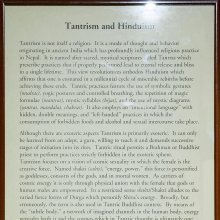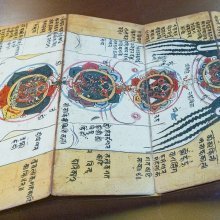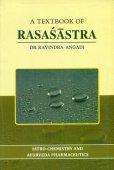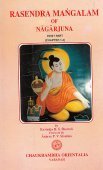Human body: 1 definition
Introduction:
Human body means something in the history of ancient India. If you want to know the exact meaning, history, etymology or English translation of this term then check out the descriptions on this page. Add your comment or reference to a book if you want to contribute to this summary article.
Images (photo gallery)
India history and geography
Source: Yale Journal of Music & Religion: Ritual Music in Contemporary Brahmanical Tantric Temples of KeralaThe Human Body, in Tantra, is a representation of an emanationist cosmology that proceeds as a movement from the pure to the impure and from the subtle to the gross. In other words, the structure of the body is a reflection of the hierarchical structure of the cosmos, and is itself thought to be an emanation from a higher level.—(Cf. Gavin Flood, The Tantric Body)—In this perspective, salvation is conceived as a pathway back through the levels of the cosmos from the impure to the pure to its source, and the Human Body, which is an icon of the cosmos, is conceived as the path itself.
Furthermore, as the Human Body is a process and narrates the emanation of the cosmos and its reabsorption into the source, Tantric ritual is also a process and a narration. This means that Tantric rituals may be read as meaningful sequences of actions and may be interpreted as representations or enactments of a process or as dramatizations of philosophical teachings—a kind of text. However, while the body is considered by all Tantric traditions as a cosmos, as a path that has to be known and as a means of knowledge, it is mapped in tradition-specific and text-specific ways through ritual and interior practice
The Temple is a replica of the Human Body and the five enclosures (pañcaprākāras) represent the five sheaths (pañcakośa) that constitute it. They are the physical sheath (annamaya-kośa), the vital body sheath (prāṇamaya-kośa), the mental sheath (manomaya-kośa), the intellectual sheath (vijñānamaya-kośa), and the bliss sheath (anandamaya-kośa). These five sheaths represent the physical body of the deity on the horizontal plane. Another category of correspondences between the Temple and the Human Body (according to texts and performers) is established on the vertical plane, and in this case it relates to the so-called energetic centers (cakras) situated along the internal channel in the spine. [...]

The history of India traces the identification of countries, villages, towns and other regions of India, as well as mythology, zoology, royal dynasties, rulers, tribes, local festivities and traditions and regional languages. Ancient India enjoyed religious freedom and encourages the path of Dharma, a concept common to Buddhism, Hinduism, and Jainism.
See also (Relevant definitions)
Partial matches: Body.
Full-text (+731): Nrikalevara, Dvara, Naratanu, Muladhara, Adumkuvena, Sushumna, Tumbadi, Tummadi, Naradeha, Kha, Akshatasharira, Lalitanga, Keduvodal, Kettodal, Kaunapa, Alivodalu, Samdegha, Kayaguna, Palmey, Immay.
Relevant text
Search found 214 books and stories containing Human body; (plurals include: Human bodies). You can also click to the full overview containing English textual excerpts. Below are direct links for the most relevant articles:
Cidgaganacandrika (study) (by S. Mahalakshmi)
Verse 87 [Śakterādya, Parināma, Prānā] < [Chapter 3 - Third Vimarśa]
Verse 260 [Human body is Śakti’s] < [Chapter 4 - Fourth Vimarśa]
Verse 245 [Yamakāli] < [Chapter 4 - Fourth Vimarśa]
Jnaneshwari (Bhavartha Dipika) (by Ramchandra Keshav Bhagwat)
Verse 8.5 < [Chapter 8 - Akshara-brahman-yoga]
Verse 15.2 < [Chapter 15 - Purusottama-yoga]
Verse 6.8 < [Chapter 6 - Dhyana-yoga]
The Skanda Purana (by G. V. Tagare)
Chapter 28 - Greatness of the Manuṣya Tīrtha < [Section 3 - Arbuda-khaṇḍa]
Chapter 22 - The Origin of Viśalyā < [Section 3 - Revā-khaṇḍa]
Chapter 78 - The Greatness of Nāradeśvara (nārada-īśvara-tīrtha) < [Section 3 - Revā-khaṇḍa]
Mahabharata (English) (by Kisari Mohan Ganguli)
Section 3 < [Mahaprasthanika Parva]
Section CLXVI < [Ghatotkacha-badha Parva]
Section XXX < [Putradarsana Parva]
The Devi Bhagavata Purana (by Swami Vijñanananda)
Chapter 1 - On the superiority of Rudra over Viṣṇu < [Book 5]
Chapter 8 - On the King Revata and the Solar Dynasty < [Book 7]
Chapter 30 - On the glory of Mahā Māyā < [Book 6]
Paramahansayogananda’s “Whispers from < [July – September, 1995]
Fun with the Gun < [January – March, 2002]
The Sea < [April – June, 1990]
Related products
(+1 more products available)










